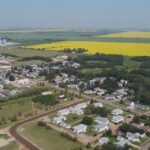The skies above Flin Flon have turned an ominous orange as a raging wildfire, fueled by exceptionally dry conditions, continues to threaten the northern Manitoba mining community, forcing thousands of residents to evacuate their homes with little notice this week.
“I grabbed my children, our important documents, and whatever clothes I could stuff into a bag,” said Sarah Mackenzie, a resident who fled with her family Tuesday night. “The smoke was so thick you could barely see across the street. It was terrifying.”
Nearly 6,000 residents from Flin Flon and surrounding areas have been displaced as provincial emergency officials issued mandatory evacuation orders when the wildfire, which began in a remote area northwest of the city, rapidly expanded due to high winds and tinder-dry forest conditions. The Manitoba Emergency Measures Organization reports the fire has consumed over 15,000 hectares of land and continues to spread despite efforts to contain it.
Environment Canada meteorologist Mark Thompson offered a glimmer of hope in a morning briefing: “We’re tracking a weather system that could bring significant rainfall to the region within 48 hours. If these projections hold, it could provide crucial assistance to firefighting efforts.” However, he cautioned that changing wind patterns could still pose challenges even with precipitation.
The evacuation has created logistical challenges for emergency services, with temporary shelters established in The Pas and Thompson reaching capacity. Provincial authorities have coordinated with neighboring Saskatchewan to accommodate additional evacuees in Prince Albert and Saskatoon.
Manitoba’s Minister of Natural Resources, James Wilson, announced the deployment of additional firefighting resources from across Canada. “We’ve received commitments for water bombers from Ontario and Alberta, and specialized personnel from British Columbia,” Wilson stated during a press conference. “This interprovincial cooperation is essential as we battle these extreme conditions.”
The Flin Flon wildfire represents the most significant threat to the community since its founding in 1927. The mining town, built around Hudbay Minerals’ operations, faces potential economic impacts beyond the immediate safety concerns. Company officials have suspended mining operations indefinitely, affecting hundreds of workers already displaced by the evacuation.
Local Indigenous communities have been particularly vulnerable during this crisis. Elder Joseph Redsky from the nearby Mathias Colomb Cree Nation expressed concern about cultural sites in the fire’s path: “These forests hold our history, our medicine gathering places. This isn’t just about buildings; it’s about our connection to the land.”
Climate scientists point to this event as consistent with projections for the region under climate change scenarios. Dr. Elena Patel from the University of Manitoba’s Climate Research Institute noted, “Northern Manitoba has experienced a 20% decrease in average spring rainfall over the past decade, while seeing temperature increases averaging 1.8°C above historical norms. These conditions create perfect scenarios for wildfire events of increasing frequency and intensity.”
Provincial health authorities have issued air quality warnings for communities as far as 300 kilometers from the fire zone, with particulate matter readings exceeding safe thresholds. Vulnerable populations, including those with respiratory conditions, have been advised to remain indoors with air filtration systems when possible.
As evacuees settle into temporary accommodations, the psychological impact of displacement compounds the physical challenges. Community support networks have mobilized quickly, with donation centers established in Winnipeg and other major centers collecting essential supplies for those affected.
The wildfire crisis raises important questions about northern community resilience in the face of increasing climate-related emergencies. As Flin Flon residents wait anxiously for news about their homes and community, will this event prompt a reassessment of emergency preparedness strategies for vulnerable northern communities across Canada?

























